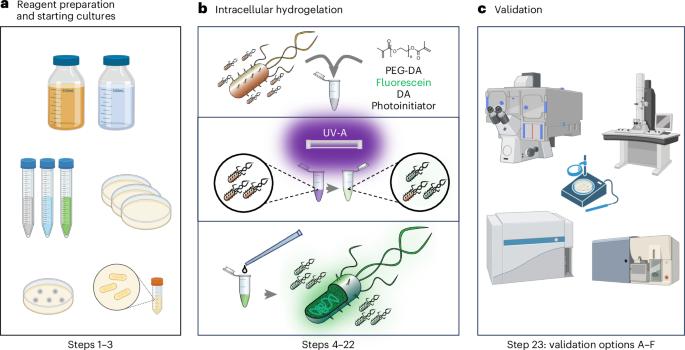利用细胞内水凝胶技术制造作为活细胞-材料混合物的半机械细菌细胞。
IF 13.1
1区 生物学
Q1 BIOCHEMICAL RESEARCH METHODS
引用次数: 0
摘要
活体疗法的生产、基于细胞的药物输送和基因编辑工具以及生物商品的制造都有一个共同的概念:它们都使用合成或活体细胞基质来实现其主要的工程或治疗目标。活细胞底盘因其自动复制特性和细胞环境的复杂性而面临固有的局限性。这种局限性凸显了人们对结合合成材料的工程简易性和天然细胞的功能性的新底盘的需求。在这里,我们描述了一种在细菌细胞内组装合成聚合物网络的方案,使细菌细胞无法进行细胞分裂,并使其能够抵御环境压力,如高 pH 值、过氧化氢和细胞壁靶向抗生素,否则未经改造的细菌将被杀死。本细胞生物工程方案详细介绍了如何将细菌转化为可抵抗环境压力并具有可编程功能的单寿命装置。我们将改造后的细菌命名为半机械细菌细胞。该方案扩展了合成生物学工具集,可对活细胞进行精确控制,并为生物技术、生物医学工程和活体治疗创造了一个多功能细胞底盘。该方案的实施需要微生物学技术、水凝胶化学、荧光显微镜和流式细胞术方面的专业知识。对半机械细菌细胞的进一步功能化和方案的调整需要从合成基因电路工程到水凝胶聚合化学的各种技能。本文章由计算机程序翻译,如有差异,请以英文原文为准。


Fabrication of cyborg bacterial cells as living cell–material hybrids using intracellular hydrogelation
The production of living therapeutics, cell-based delivery of drugs and gene-editing tools and the manufacturing of bio-commodities all share a common concept: they use either a synthetic or a living cell chassis to achieve their primary engineering or therapeutic goal. Live-cell chassis face limitations inherent to their auto-replicative nature and the complexity of the cellular context. This limitation highlights the need for a new chassis combining the engineering simplicity of synthetic materials and the functionalities of natural cells. Here, we describe a protocol to assemble a synthetic polymeric network inside bacterial cells, rendering them incapable of cell division and allowing them to resist environmental stressors such as high pH, hydrogen peroxide and cell-wall-targeting antibiotics that would otherwise kill unmodified bacteria. This cellular bioengineering protocol details how bacteria can be transformed into single-lifespan devices that are resistant to environmental stressors and possess programable functionality. We designate the modified bacteria as cyborg bacterial cells. This protocol expands the synthetic biology toolset, conferring precise control over living cells and creating a versatile cell chassis for biotechnology, biomedical engineering and living therapeutics. The protocol, including the preparation of gelation reagents and chassis strain, can be completed in 4 d. The implementation of the protocol requires expertise in microbiology techniques, hydrogel chemistry, fluorescence microscopy and flow cytometry. Further functionalization of the cyborg bacterial cells and adaptation of the protocol requires skills ranging from synthetic genetic circuit engineering to hydrogel polymerization chemistries. This protocol describes the generation of cyborg bacterial cells by using intracellular hydrogelation. These nondividing, stressor-resistant engineered bacteria chassis can find application as living environmental biosensors and in disease treatment.
求助全文
通过发布文献求助,成功后即可免费获取论文全文。
去求助
来源期刊

Nature Protocols
生物-生化研究方法
CiteScore
29.10
自引率
0.70%
发文量
128
审稿时长
4 months
期刊介绍:
Nature Protocols focuses on publishing protocols used to address significant biological and biomedical science research questions, including methods grounded in physics and chemistry with practical applications to biological problems. The journal caters to a primary audience of research scientists and, as such, exclusively publishes protocols with research applications. Protocols primarily aimed at influencing patient management and treatment decisions are not featured.
The specific techniques covered encompass a wide range, including but not limited to: Biochemistry, Cell biology, Cell culture, Chemical modification, Computational biology, Developmental biology, Epigenomics, Genetic analysis, Genetic modification, Genomics, Imaging, Immunology, Isolation, purification, and separation, Lipidomics, Metabolomics, Microbiology, Model organisms, Nanotechnology, Neuroscience, Nucleic-acid-based molecular biology, Pharmacology, Plant biology, Protein analysis, Proteomics, Spectroscopy, Structural biology, Synthetic chemistry, Tissue culture, Toxicology, and Virology.
 求助内容:
求助内容: 应助结果提醒方式:
应助结果提醒方式:


